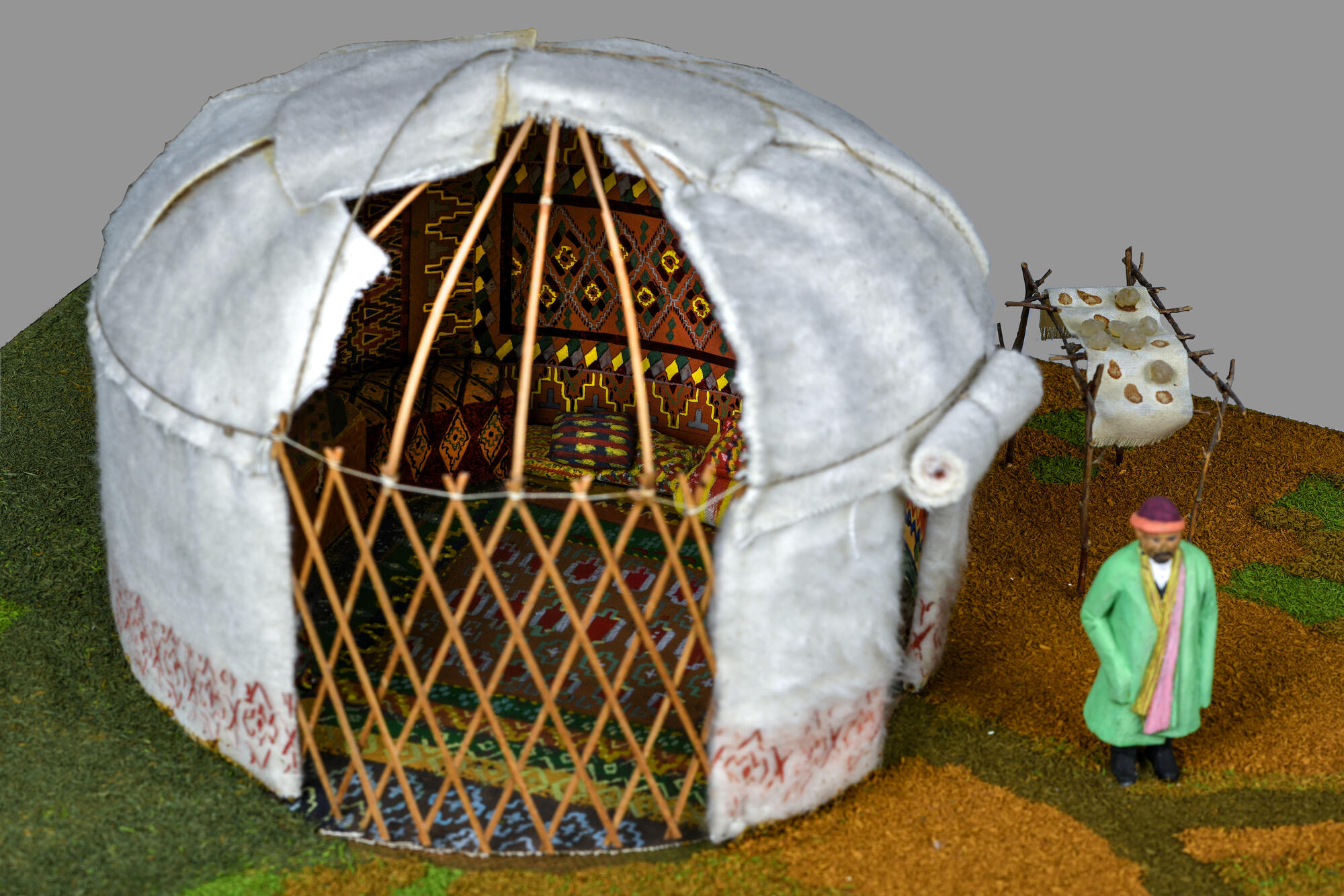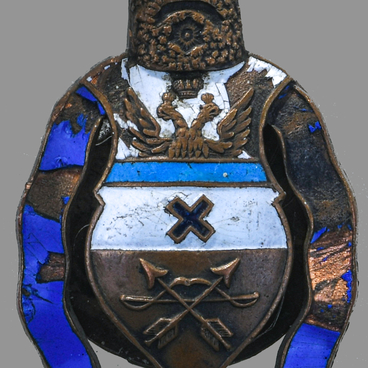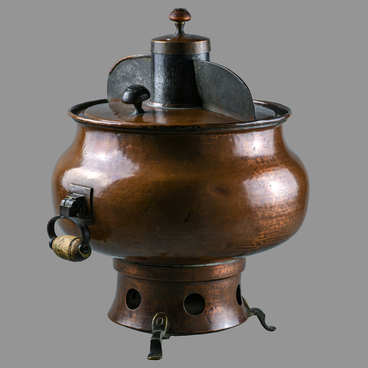On February 19 1731 the Lesser Horde of the Kirghiz-Kaisak became Russian subjects. Before the first Orenburg fortress was established, at the confluence of the River Yaik and River Or, the Kirghiz-Kaisak (Kazakhs) roamed freely over the steppes. When winter arrived they migrated further south, to warmer climes.
The Kazakhs’ agriculture, customs and culture all had very distinctive features, which were the result of their nomadic way of life.
Animal husbandry was a core economic activity and dominated their daily routine. The animals gave milk and meat, as well as wool for clothing. Livestock also formed their main means of transport. Different tribes specialized in raising cows, oxen and buffalo. The most important animals were semi-nomadic cattle. They could feed the whole year on the grass that grew underfoot.
In the XV- XVII Centuries the Kazakhs’ most important domestic animals were camels, sheep and horses. They raised both racing and draught horses. The Cossacks raised both dromedaries (nar tuiye) and two-humped Bactrian camels. The livestock lived outside throughout the year. In winter the Kazakhs covered their animals with warm blankets.
They chose the pasture lands according to the season: in winter (kystau) they lived on the shores of lakes, where rushes grew. Gorges, the margins of woods, and hilly sandy desert areas were also considered suitable wintering habitats.
In the spring (koktey) and autumn (kuzey) the best pastures were areas that had been warmed in the sun and free of snow for a long time. And for their summer (khailau) pasture they chose cool river valleys, and shady areas free from flies and mosquitoes. The dug shallow ditches or wells to provide their animals with a source of drinking water. Each community had its own routes and pasture lands.
The Kazakhs’ agriculture, customs and culture all had very distinctive features, which were the result of their nomadic way of life.
Animal husbandry was a core economic activity and dominated their daily routine. The animals gave milk and meat, as well as wool for clothing. Livestock also formed their main means of transport. Different tribes specialized in raising cows, oxen and buffalo. The most important animals were semi-nomadic cattle. They could feed the whole year on the grass that grew underfoot.
In the XV- XVII Centuries the Kazakhs’ most important domestic animals were camels, sheep and horses. They raised both racing and draught horses. The Cossacks raised both dromedaries (nar tuiye) and two-humped Bactrian camels. The livestock lived outside throughout the year. In winter the Kazakhs covered their animals with warm blankets.
They chose the pasture lands according to the season: in winter (kystau) they lived on the shores of lakes, where rushes grew. Gorges, the margins of woods, and hilly sandy desert areas were also considered suitable wintering habitats.
In the spring (koktey) and autumn (kuzey) the best pastures were areas that had been warmed in the sun and free of snow for a long time. And for their summer (khailau) pasture they chose cool river valleys, and shady areas free from flies and mosquitoes. The dug shallow ditches or wells to provide their animals with a source of drinking water. Each community had its own routes and pasture lands.
Apart from raising livestock, the Kazakhs also practiced related crafts, such as curing leather, making felt and sewing.
Yurts were the main home for the nomads. These wooden-framed constructions were dismantled, and the dome and poles were loaded onto carts to be transported. There were three types of yurt: for important events, for accommodation, and for storing goods, food and weapons.
In the centre of the yurt there was a hearth. It was used for cooking, and as a source of heat in winter. The place where guests and senior members of the family sat was called the ‘ter’. It was directly opposite the entrance. The Kazaks decorated their wooden household items with carvings. They kept vessels and kitchen utensils in carpetwork bags. Clothes and household items were kept in trunks.
Traditionally, the Kazakhs made their vessels out of leather. They sewed them from cow or horse leather. The skins were shaved, washed with sour milk, salted and then left to dry in the sun. Wooden vessels (flat dishes and bowls for koumiss) were carved and decorated with precious stones. Every family had its own iron cauldron, or ‘kazan’.
Yurts were the main home for the nomads. These wooden-framed constructions were dismantled, and the dome and poles were loaded onto carts to be transported. There were three types of yurt: for important events, for accommodation, and for storing goods, food and weapons.
In the centre of the yurt there was a hearth. It was used for cooking, and as a source of heat in winter. The place where guests and senior members of the family sat was called the ‘ter’. It was directly opposite the entrance. The Kazaks decorated their wooden household items with carvings. They kept vessels and kitchen utensils in carpetwork bags. Clothes and household items were kept in trunks.
Traditionally, the Kazakhs made their vessels out of leather. They sewed them from cow or horse leather. The skins were shaved, washed with sour milk, salted and then left to dry in the sun. Wooden vessels (flat dishes and bowls for koumiss) were carved and decorated with precious stones. Every family had its own iron cauldron, or ‘kazan’.
The nomads’ way of life was reflected in their traditional costume. Outer garments were sewn from fur of raccoon, sable or more often goat and sheep wool. Trousers were made of suede, and embroidered. Robes and cloaks were made from white felt. In summer the men wore shirts, trousers and robes. Women wore long tunics, cut like dresses, and sleeveless robes.
Hats were an important part of their wardrobe. From the XV- XVII Centuries they came in a wide variety of forms, from simple summer caps to wedding hats trimmed with fur. The traditional man’s felt hat was known as a ‘kalpak’. In the spring and autumn both men and women wore round conical hats covered with fur.
Embroidered leather, velvet or silk belts, hunting boots and shoes were very important items of clothing in Kazakh culture. They were a sign of the wearer’s status and how wealthy he was.
In the XV- XVIII Centuries every aspect of the Kazakhs’ material culture was dictated by their nomadic lifestyle. Their possessions were made of the materials available to them, and were easily transportable.
Hats were an important part of their wardrobe. From the XV- XVII Centuries they came in a wide variety of forms, from simple summer caps to wedding hats trimmed with fur. The traditional man’s felt hat was known as a ‘kalpak’. In the spring and autumn both men and women wore round conical hats covered with fur.
Embroidered leather, velvet or silk belts, hunting boots and shoes were very important items of clothing in Kazakh culture. They were a sign of the wearer’s status and how wealthy he was.
In the XV- XVIII Centuries every aspect of the Kazakhs’ material culture was dictated by their nomadic lifestyle. Their possessions were made of the materials available to them, and were easily transportable.



